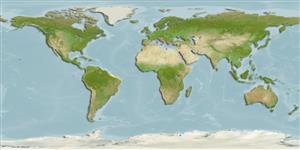Eudendrium merulum Watson, 1985
| Native range | All suitable habitat | Point map | Year 2050 |

|
| This map was computer-generated and has not yet been reviewed. |
| Eudendrium merulum AquaMaps Data sources: GBIF OBIS |
Upload your photos
Google image |
No photo available for this species.No drawings available for Eudendriidae.
Google image |
No photo available for this species.
Classification / Names Common names | Synonyms | CoL | ITIS | WoRMS
Hydrozoa | Anthoathecata | Eudendriidae
Environment: milieu / climate zone / depth range / distribution range Ecology
Benthic; depth range 1 - 10 m (Ref. 3086). Tropical
Distribution Countries | FAO areas | Ecosystems | Occurrences | Introductions
Circumtropical.
Length at first maturity / Size / Weight / Age
Maturity: Lm ? range ? - ? cm
Short description Morphology
Complementary nematocysts microbasic euryteles, having a much ornamented shaft; male blastostyles completely reduced, with distinct neck connecting gonophore chambers; female blastostyles fully reduced, spadix unbranched during early ontogeny, shed when mature; eggs with thin pellicle, placed along axis of blastostyle (Ref. 3086).
Maximum depth from Ref. 3100. Occurs in shallow waters from 1 to 10 m in depth, on rocks and barnacles (Ref. 3086 and 3100). It prefers shaded microhabitats and current flows, where it can form extensive meadows (Ref. 3101).
Life cycle and mating behavior Maturity | Reproduction | Spawning | Eggs | Fecundity | Larvae
Members of the order Anthoathecata are mostly colonial A-form hydroids. Life cycle: The zygote develops into planula inside the gonophore and is later released as an actinula which metamorphoses into polyp stage.
Main reference
References | Coordinator | Collaborators
Migotto, A.E., A.C. Marques, A.C. Morandini and F.L. da Silveira. 2002. (Ref. 813)
IUCN Red List Status (Ref. 130435)
CITES status (Ref. 108899)
Not Evaluated
CMS (Ref. 116361)
Not Evaluated
Threat to humans
Harmless
Human uses
| FishSource |
Tools
More information
Internet sources
BHL | BOLD Systems | CISTI | DiscoverLife | FAO(Publication : search) | Fishipedia | GenBank (genome, nucleotide) | GloBI | Gomexsi | Google Books | Google Scholar | Google | PubMed | Tree of Life | Wikipedia (Go, Search) | Zoological Record
Estimates based on models
Preferred temperature
(Ref. 115969): 17.8 - 25.9, mean 19.3 (based on 285 cells).
Price category
(Ref. 80766):
Unknown.


